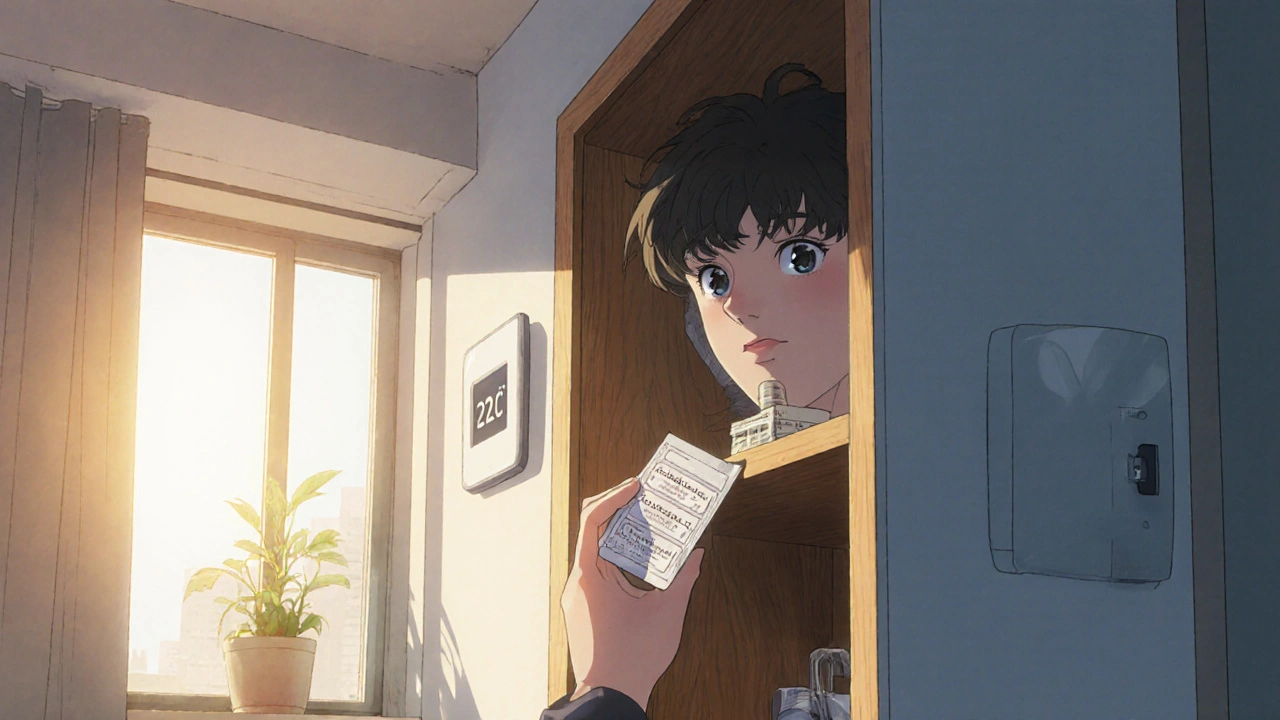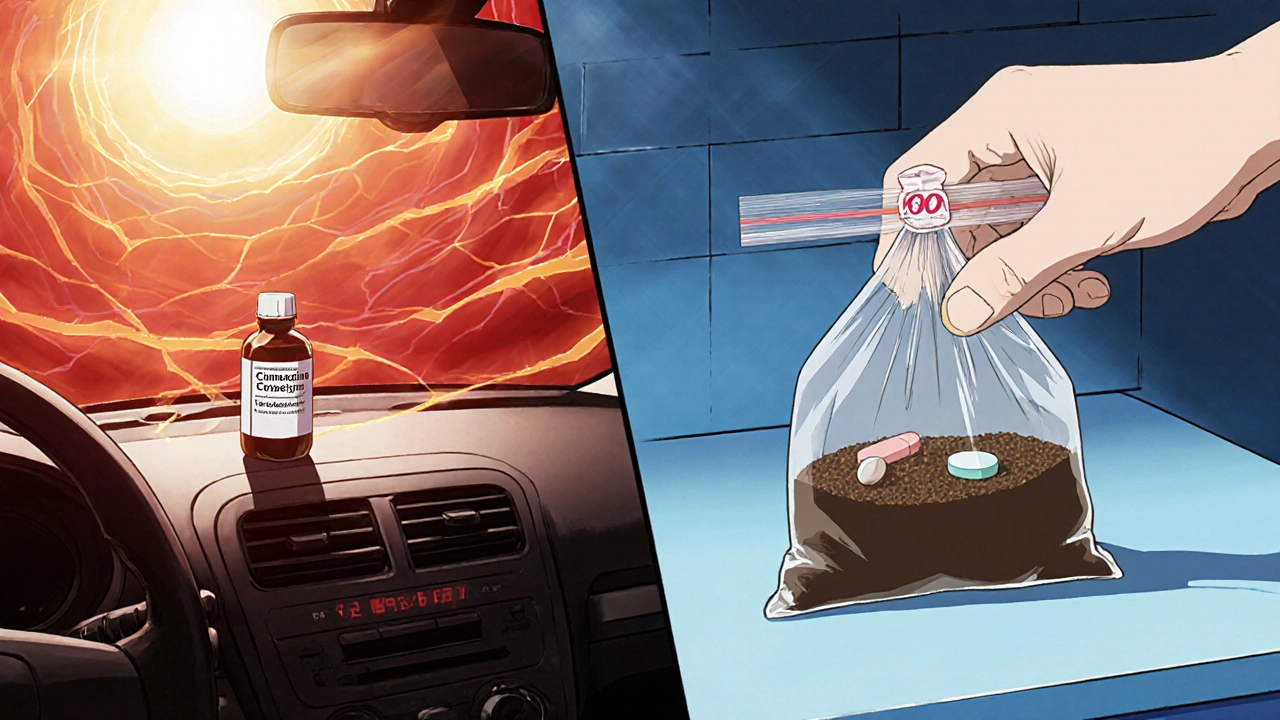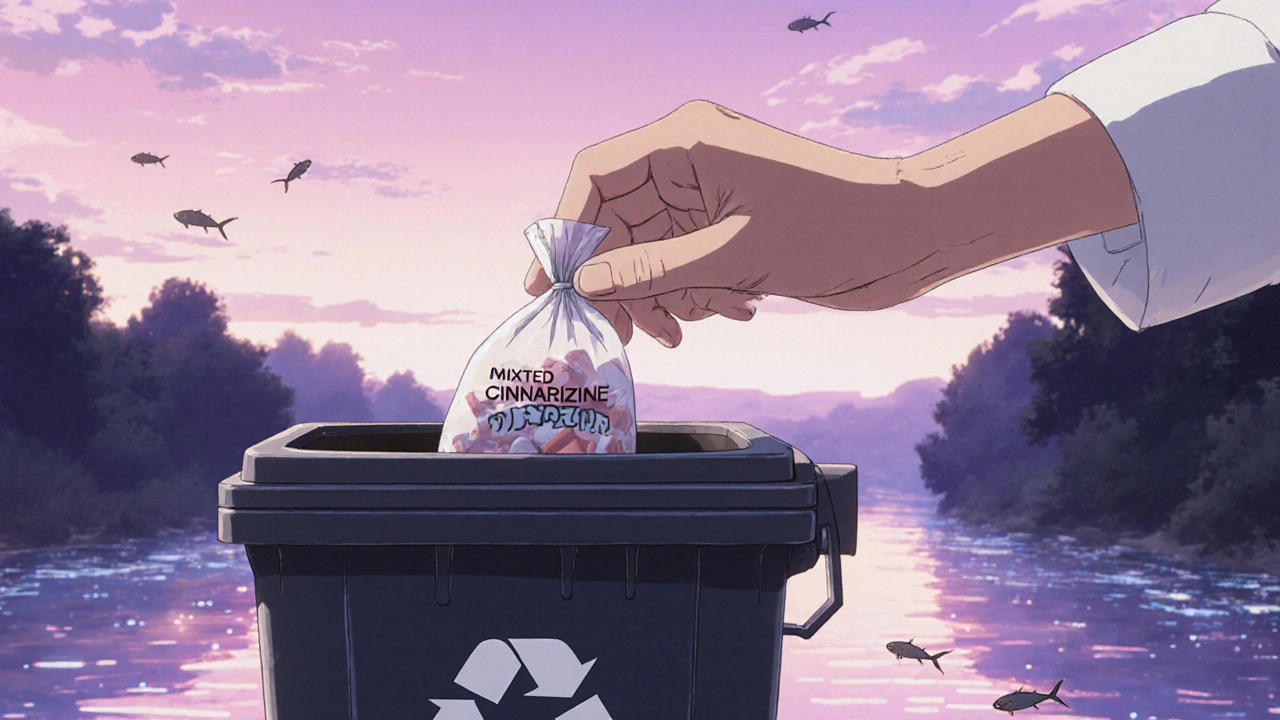Safe Storage & Disposal Guide for Cinnarizine

When handling Cinnarizine is a prescription drug classified as a calcium channel blocker with antihistamine effects, used mainly for vertigo and motion sickness, proper storage and disposal are crucial to keep you safe and protect the environment.
Why Proper Storage Matters
Even a tiny lapse in storage can change a tablet’s potency, lead to accidental ingestion, or create hazardous waste. Antihistamine properties of cinnarizine help calm inner‑ear signals, but those same chemicals can become unstable if exposed to heat, moisture, or direct sunlight. When the drug breaks down, you risk reduced effectiveness for your condition and potentially irritating by‑products that could irritate skin or lungs.
Ideal Storage Conditions for Cinnarizine
The medication should stay in its original Blister Pack or bottle with child‑proof cap, which provides a barrier against humidity. Keep the container in a cool, dry place-ideally between 20°C and 25°C (68°F‑77°F). Avoid bathrooms, kitchens, or anywhere the temperature swings more than 5°C (9°F) in a day.
Below is a quick reference for temperature and light exposure:
| Condition | Recommended Range | What Happens If Exceeded |
|---|---|---|
| Temperature | 20‑25°C (68‑77°F) | Active ingredient degrades, tablet may crumble |
| Humidity | ≤ 60% RH | Moisture absorption, reduced dose consistency |
| Light | Store away from direct sunlight | Photodegradation, discoloration |
Following these cinnarizine storage guidelines will keep the drug effective until its expiration date.
Common Mistakes to Avoid
- Leaving the bottle in a car dashboard during summer-temperatures can soar above 40°C (104°F).
- Mixing old and new supplies, which makes it hard to track expiry.
- Discarding tablets in the trash without checking local regulations; many municipalities treat them as Hazardous Waste because active pharmaceutical ingredients can leach into groundwater.
- Sharing unused pills with friends or family-dosage and health conditions differ.

How to Dispose of Unused or Expired Cinnarizine
The safest route is a pharmacy take‑back program. Pharmacy staff are trained to handle and destroy medications in compliance with federal and state regulations. If a nearby pharmacy participates, simply drop the original container (or a sealed bag) into the designated collection box.
When a pharmacy isn’t an option, the FDA provides guidelines for household disposal when no take‑back program is accessible recommends these steps:
- Mix the pills with an undesirable substance like used coffee grounds or cat litter.
- Seal the mixture in a sturdy plastic bag or container.
- Throw the sealed bag in the regular trash.
- Remove all personal information from the original prescription label before discarding the bottle.
Do NOT flush cinnarizine down the toilet or sink. Wastewater treatment plants are not designed to remove all pharmaceutical residues, and research shows traces can end up in rivers, affecting aquatic life.
Disposal Options: Household vs. Pharmacy Take‑Back
| Method | Pros | Cons |
|---|---|---|
| Pharmacy Take‑Back | Certified destruction, zero environmental risk | May require travel to a participating location |
| Household Trash (mix & seal) | Convenient, no special trip needed | Potential for accidental ingestion if not sealed properly |
| Community Collection Events | Often free, organized by local health departments | Schedules are intermittent |

Step‑by‑Step Disposal Guide
- Check the expiration date. If the medication is still within its usable period, consider donating it to a vetted program that accepts unopened, unexpired meds.
- Gather all remaining cinnarizine-tablets, capsules, and any liquid form.
- Choose your disposal route: pharmacy take‑back, community event, or household trash.
- If using the trash method, follow the FDA mixing instructions above.
- Document the disposal date for your records, especially if you’re managing multiple prescriptions.
Protecting the Environment and Your Health
Improper disposal doesn’t just risk personal safety; it can harm wildlife. Studies by the EPA (Environmental Protection Agency) have detected trace levels of antihistamines in river sediment, which can affect fish reproduction cycles. By following the steps above, you’re doing your part to keep waterways clean.
For families with children, always store cinnarizine out of reach-use a locked cabinet or a high shelf. A quick reminder from your Healthcare Provider can reinforce safe storage habits during each appointment helps prevent accidental ingestion.
Frequently Asked Questions
Can I flush cinnarizine down the toilet?
No. Flushing leaves active ingredients in wastewater, which treatment plants often can’t fully remove. The drug can end up in rivers and harm aquatic ecosystems.
Is it safe to keep expired cinnarizine in the pantry?
Expired tablets may lose potency and could become chemically unstable. Store them separately and dispose of them as soon as possible using the methods described above.
Do all pharmacies accept medication take‑back?
Most large chain pharmacies do, but it’s best to call ahead. Some independent stores participate through local health‑department programs.
What if I only have a few pills left?
Even a small amount should be disposed of properly. Mix the few pills with an undesired substance and seal them, or bring the tiny quantity to a pharmacy take‑back box.
Can I donate unopened cinnarizine to a charity?
Only if the medication is unexpired, unopened, and the charity explicitly accepts prescription meds. Most organizations prohibit prescription drug donations because of legal and safety concerns.

Kathrynne Krause
October 21, 2025 AT 18:23Storing cinnarizine like a treasure chest-cool, dry, and out of sight-makes total sense. I love the colorful reminder to keep it away from bathroom humidity. Mixing it with coffee grounds? Genius hack for the trash method. Let’s all lock those cabinets and keep the meds safe for our families. 🌈
Chirag Muthoo
October 25, 2025 AT 18:23It is advisable to maintain the recommended temperature range of 20‑25 °C for cinnarizine to preserve its efficacy. Additionally, securing the original container with a child‑proof cap prevents accidental ingestion. The mentioned pharmacy take‑back programs comply with federal regulations and minimize environmental impact. Please ensure personal data on prescription labels is removed before disposal.
Ivan Laney
October 29, 2025 AT 18:23Cinnarizine, being a calcium channel blocker with antihistamine properties, deserves meticulous handling to safeguard both patient health and ecological balance. First, the drug should never be stored in locations where temperature fluctuations exceed five degrees Celsius, as thermal stress accelerates active ingredient degradation. Second, humidity above sixty percent relative humidity can infiltrate blister packs, causing tablets to crumble and deliver uneven dosages. Third, direct sunlight induces photodegradation, leading to discoloration and the formation of potentially irritant by‑products. Fourth, the original packaging provides a barrier, but once compromised, the risk of moisture absorption skyrockets. Fifth, keeping the medication in a locked cabinet or high shelf is essential for households with children or pets. Sixth, regularly checking expiration dates prevents the use of compromised tablets that may have lost potency. Seventh, when a medication reaches its end of life, the most responsible option is a pharmacy take‑back program, which ensures certified destruction. Eighth, if a take‑back facility is unavailable, the FDA’s mix‑and‑seal method-combining pills with an undesirable substance such as used coffee grounds-reduces the chance of accidental ingestion from trash. Ninth, sealing the mixture in a sturdy, opaque container prevents leaks and deters curiosity. Tenth, removing all personal identifiers from the prescription label protects privacy and complies with disposal regulations. Eleventh, disposing of cinnarizine in the toilet or sink is prohibited because wastewater treatment plants cannot fully eliminate pharmaceutical residues. Twelfth, studies have demonstrated that traces of antihistamines can persist in river sediments, affecting aquatic organisms’ reproductive cycles. Thirteenth, community collection events, while intermittent, offer a free and organized avenue for safe disposal. Fourteenth, donating unopened, unexpired medication is permissible only when the receiving organization explicitly accepts prescription drugs, adhering to legal constraints. Fifteenth, documenting the disposal date in a personal health log can be useful for future reference and medical audits. Sixteenth, by adhering to these comprehensive storage and disposal practices, individuals contribute to public health safety and environmental stewardship.
Vivian Annastasia
November 2, 2025 AT 18:23Oh, brilliant, because we all have a spare bag of coffee grounds just lying around for emergency pill disposal. Sure, let’s trust that a random trash can won’t become a mini‑pharmacy for curious kids. Maybe next you’ll suggest sprinkling the meds on the lawn for extra “eco‑friendly” fertiliser.
John Price
November 6, 2025 AT 18:23Keep it cool and out of the kids' reach.
Jake Hayes
November 10, 2025 AT 18:23The take‑back option remains the gold standard; it guarantees certified destruction without environmental risk, unlike the household trash method which still carries a contamination possibility.
parbat parbatzapada
November 14, 2025 AT 18:23Yo, they don’t tell ya that the “gold standard” is just a front for the pharmaco‑elite to recycle our meds into secret experiments. Keep your eyes open, man, they’re probably mixing it with some mind‑control serum in the shadows.
Casey Cloud
November 18, 2025 AT 18:23Quick tip: put the pills in a sealed zip‑lock bag with used cat litter then toss it in the regular trash yeah that works fine
Dana Yonce
November 22, 2025 AT 18:23Got it! This makes disposal way less scary 😊
Lolita Gaela
November 26, 2025 AT 18:23From a pharmacokinetic perspective, cinnarizine's lipophilicity necessitates hermetic containment to prevent desiccation-mediated hydrolysis, thereby preserving its bioavailability profile until point of use. Implementing a controlled‑environment storage protocol mitigates N‑dealkylation pathways that could otherwise generate reactive metabolites with potential dermal irritancy. Consequently, the pharmaco‑environmental impact is attenuated when the compound is sequestered in high‑density polyethylene containers that impede photon‑induced isomerization.
Giusto Madison
November 30, 2025 AT 18:23Exactly, lock that meds up and treat that storage like a training drill-no excuses, just follow the SOP and you’ll keep both your health and the planet in top shape.
Xavier Lusky
December 4, 2025 AT 18:23Remember, the government tracks all prescription waste; every discarded pill adds to the data they harvest for unknown experiments.